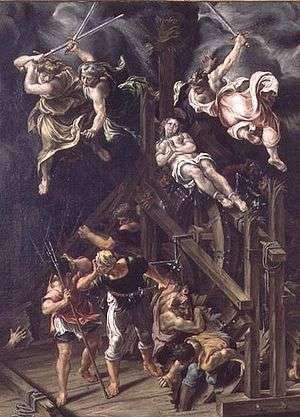Lelio Orsi
Lelio Orsi (1508/1511 – 1587), also known as Lelio da Novellara, was a Mannerist painter and architect of the Reggio Emilia school in northern Italy.[1][2]

| Wikimedia Commons has media related to Lelio Orsi. |
He was born and died in Novellara, and much of his work was completed in Reggio. He appears to have studied under such as Giovanni Giarola, a pupil of Antonio da Correggio. There is documentary evidence that he visited Rome in 1554–55, and may have been influenced by Girolamo Bedoli, Correggio and the prototypic mannerists Giulio Romano as well as Michelangelo and his successor Daniele da Volterra. He is said to have trained Raffaellino da Reggio. Other pupils or followers were Giovanni Bianchi, known as il Bertone Reggiano.[3] and Jacopo Borbone of Novellara.[4] He was active in both exterior and interior decoration, and much of his work is in small cabinet pieces, not large altarpieces. Much of his output ended in the collections of the Dukes of Este in Ferrara. Orsi appears to be "reading" Correggio with the lens of Mannerism: the nocturnal, limned ethereal simplicity of Correggio here is constrained into contorted poses, perspective distorted, and settings crowded. The effect at times is unsettling. While the angels above unsheathing divine swords are meant to carry the day in The Martyrdom of Saint Catherine it appears that the execution was stymied by breakdown within the complex set of depicted gears.
Selected attributions
- The Martyrdom of Saint Catherine (1560) - Galleria Estense, Modena
- The Dead Christ Flanked by Charity and Justice
- Madonna della Ghiara (1569)
- Saints Cecilia & Valerian - Galleria Borghese, Rome
- Noli Me Tangere - Wadsworth Atheneum, Hartford
- The Adoration of the Shepherds (1565–70) - Gemäldegalerie, Berlin[5]
- The Walk to Emmaus (1565) - National Gallery, London[6]
- St. George and the Dragon (1550) - Museo di Capodimonte, Naples
- St Michael subduing Satan and weighing the Souls of the Dead (1540s) - Ashmolean Museum, Oxford[7]
- Christ in the Garden of Gethsemane (1545) - Strossmayer Gallery, Zagreb
References
- "Órsi, Lelio, detto Lelio da Novellara". Treccani (in Italian). Retrieved 28 November 2013.
- Griswold, William (1994). Griswold, William M; Wolk-Simon, Linda (eds.). Sixteenth-century Italian Drawings in New York Collections. New York: Metropolitan Museum of Art. pp. 12–13, 148. ISBN 978-0-87099-688-7.
- Tiraboschi, Girolamo (1786). Notizie de' pittori, scultori, incisori, e architetti natii degli stati del Serenissimo Signor Duca di Modena. Presso la Societa' Tipografica, Modena; Digitized by Googlebooks. p. 121.
- G. Tiraboschi, page 126.
- "Orsi Lelio, Adorazione dei pastori" (in Italian). Fondazione Federico Zeri. Retrieved 28 November 2013.
- "The Walk to Emmaus". London: The National Gallery. Retrieved 28 November 2013.
- "Attributed to Lelio Orsi (1508/11 - 1587): St Michael subduing Satan and weighing the Souls of the Dead". From: Complete Illustrated Catalogue of Paintings. Ashmolean Museum of Art and Archeology, University of Oxford. Retrieved 28 November 2013.
- Freedberg, Sydney J. (1993). Painting in Italy, 1500-1600. Penguin Books. pp. 577–679.
- Smyth, Francis P. (1986). John P. O'Neill (ed.). The Age of Correggio and the Carracci: Emilian Painting of the 16th and 17th Centuries. Washington DC: National Gallery of Art. pp. 150–158.
- Eitel-Porter, Rhoda (2017). Lelio Orsi, Antonio Pérez and The Minotaur Before a Broken Labyrinth. http://www.printquarterly.com/images/contents/PQMAR2017.pdf. Print Quarterly Vol.XXXIV No.1. pp. 11–19. External link in
|website=(help)